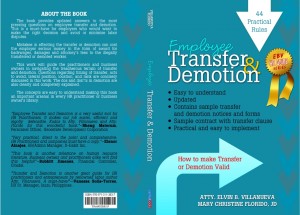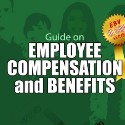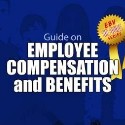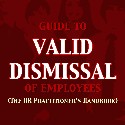Sales are the lifeblood of businesses, big and small. Employee performance and the management of human resources are vital as well in business.
Call centers, pharmaceutical companies and manufacturing enterprises often review sales performance of employees against quotas and other performance standards. The usual problem arises when an employee fails to meet these standards yet management still feels that it’s possible to retain an employee by transferring him or her to another position where his or her skills are best suited.
In other instances, companies undergo reorganization in order to streamline operations, reduce costs or change business directions. In most cases, organizational changes can result in transfers and demotions.
The question often asked is:
“Is it legal to transfer and demote an employee in the Philippines?”
Employers generally have management prerogatives which include the right to transfer and demote employees but these prerogatives are subject to certain limitations found in legal provisions and case law. These sources of law bind everyone in the Philippines, whether you know of them or not.
IGNORANCE OF THE LAW EXCUSES NO ONE
HR officers and business owners ordinarily implement decisions and later turn to lawyers for advice or worse, legal assistance, only when faced with court action. But an increasing number are now turning to law guides and lawyers for PRIOR advice to avoid serious consequences.
44 Rules on Employee Transfer and Demotion is one such guide which provides answers to the usual questions on employee transfer and demotion. This is a must-have for employers who wish to make the right decision and avoid or minimize litigation.
Mistakes in effecting the transfer or demotion can cost the employer huge sums of money in the form of an award for backwages, damages and attorney’s fees in favor of the illegally transferred or demoted worker.
KNOWLEDGE OF THE RULES WILL KEEP YOU FROM MAKING COSTLY MISTAKES!
This work can guide HR specialists, managers and business owners in making the right decisions and implementing management choices the legal way. Questions regarding timing of transfer, acts to avoid, lateral functions, location, and rank are concisely discussed in this work. The dos and don’ts in demotion are also clearly and completely explained. The concepts are easy to understand making this book an important tool in every HR practitioner or business owner’s business kit.
Read what HR managers and other responsible company officers are saying about this guide:
“Employee Transfer and Demotion is a very useful tool for HR practitioners. It makes our job easier, efficient and legally defensible. Kudos to Atty. Villanueva and Atty. Florido for this wonderful book.“ —Bheng Materum, Personnel Officer, Geoestate Corporation
“Very practical, direct to the point and comprehensive.” — Elenor Alnajes. HR/Admin Manager, X-Habit, Inc.
“This book is another milestone in Human Resource literature. Business owners and practitioners alike will find this helpful.“—– Bobbit Jimenez, Controller, Citadel
SAMPLE FORMS INSIDE BOOK
Demotions are treated as dismissals from employment. This is why the latest Supreme Court cases require employers to observe due process including the giving out of notices. Certain things must appear in the notice for it to be sufficient. This book will guide you by providing sample forms relating to demotions and transfers. Just fill them up or make some adjustments to suit the circumstances of your business or employee.
44 rules on Employee Transfer and Demotion is now available at National Book Store outlets, Fully Booked and Powerbooks. For quick and convenient purchase and reading, this guide is also available in EBook and Kindle formats, perfect for your PC, Ipad, Kindle and tablet. Ebook Price: Php 497.00









July 2nd, 2012 on :-)
Hi! I would like to know how many days will it take for me to receive the book once I purchase online. I am from Los Banos, Laguna. Thanks!